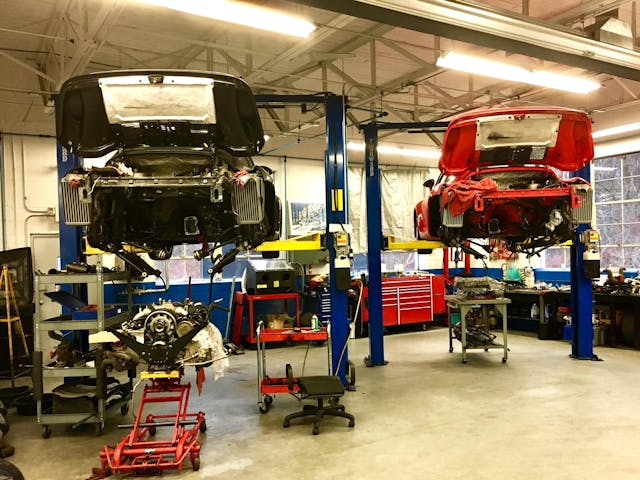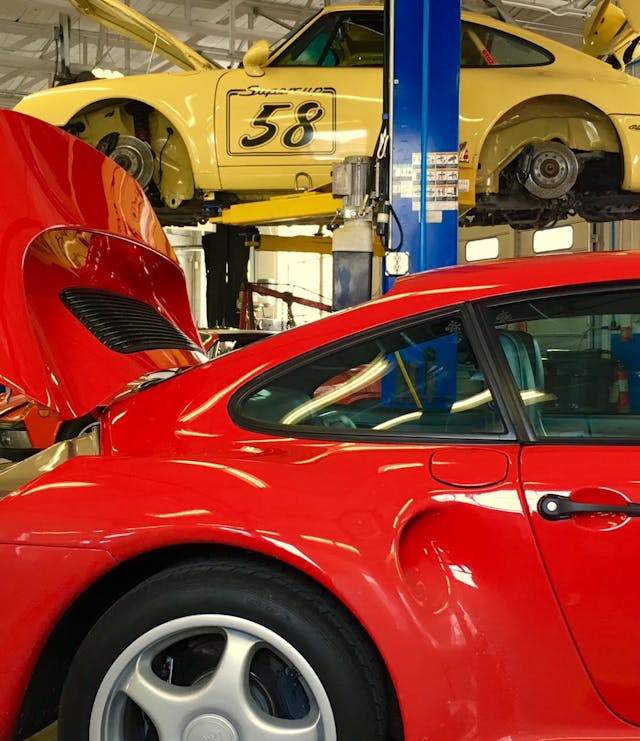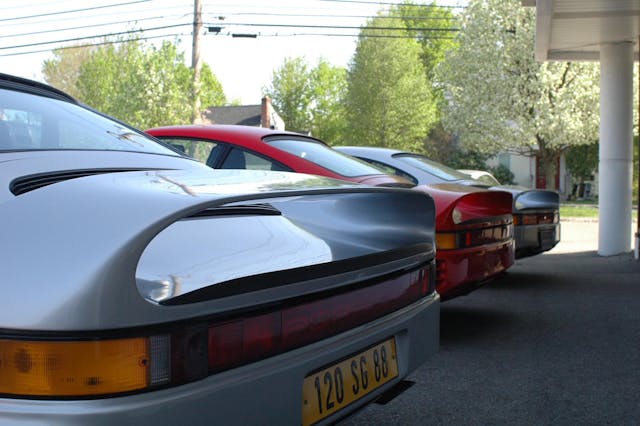See the Boston-area repair shop that has become a Mecca for Porsche owners
Porsches arrive from all over the country at Jerry Pellegrino’s repair shop in Natick, Massachusetts. Some owners drive there. Some ship their cars. “The blue [car] belongs to a collector in Florida,” says Pellegrino, indicating a 1972 911 E.
European Performance Engineering (EPE) in Natick fixes the elite of the world of Porsches, says Tom Thalmann, who since 2009 has been driving his ’03 911 more than 70 miles to EPE from his home in Rhode Island.
European Performance Engineering has worked on many million-plus dollar Porsches. That figure may reflect purchase price, and/or the fame of a former owner, as in the case of a 930 that had belonged to an Academy-Award-winning actor whom I remember vividly, despite his untimely demise more than four decades ago. (Pellegrino, who emphasizes the importance of discretion in his business, refrains from giving out information that might identify his customers.)

Other notable Porsches receiving EPE’s ministrations include “probably ten 959s, a handful of RS Carreras, of which there may be 50 in the country, a 964 #1 prototype, and one of the five 911ST rally cars that were built for the East African Rally,” says Thalmann, whose Porsche is famous for his having driven it more than 650,000 miles.
“We’re known as a bit of a specialist in certain things—air cooled engines, and 959s,” says Pellegrino. “We are entrusted with all manner of Porsches, from early 356s to the latest high tech 911s.”

“The 959s come in from as far away as California,” says Pellegrino. Built beginning in 1986, and sold only in 1987 and 1988, they “combined such forward thinking features as all wheel drive, antilock brakes, and cockpit adjustable ride height, as well as front/rear drive torque distribution, just to name a few,” says Pellegrino. Even today, they remain “a true technological tour de force.” The first 959 to enter the 6,100 mile Paris-Dakar rally, in 1986, won that race.
Production ceased prematurely when it became clear that the cost to manufacture each 959 was more than double the purchase price. Of the 329 or 337 that were made—estimates vary—only around 50 came to the US.
But even what Pellegrino refers to as “regular cars”—Porsches like Thalmann’s 911—cross state lines to be serviced and repaired at European Performance Engineering.
One notable customer who doesn’t have to cross state lines is Paul Russell, the proprietor of the eponymous antique car restoration company in Essex, MA. Among others, Russell restored Ralph Lauren’s cars, including a Bugatti Atlantic, one of several in the world. One of Russell’s restorations won Best in Show at this year’s Pebble Beach Concours d’Elegance.
Russell sends cars to Pellegrino that “are a little out of our concentrated focus area. He’s taken care of several of our clients’ 959s, which involved some deep, heavy service work that required engine removal, disassembly, and inspection,” says Russell.
Russell also sent his wife’s unrestored 1973 BMW 2002 TII to Pellegrino for mechanical work.
“If somebody calls here requesting services that I can’t provide, then it’s a great relief to have a trusted vendor that we can refer people to,” says Russell.
Working on esoteric cars can lead to esoteric problems, says Pellegrino. “With the 959, sometimes certain parts are not available. Also the prices on some of the parts are absurd… We can sometimes repair what we’ve got, [or] we can have some parts made. We might take something from another car and adapt it. When you have a car that’s worth around a million dollars, you have to fix it.”
Not all of Pellegrino’s work is repairs. Dana Martin, a long-time local customer, has a 1973 911, which he likes because it predated much of the emissions control equipment, and it’s “one of the lightest 911s.” Pellegrino informed Martin that Porsche moved so incrementally on changes that he could easily replace that car’s 2.4 liter engine with a 1995 3.6 liter engine,” along with a g50 gearbox and a hydraulic clutch, which Pellegrino then did. “Now I’ve got this almost 50 year old 911 that goes like stink!” says Martin.

Besides working in the shop, “we have also been hired to support racers in both professional and amateur events, including three very successful trips to the 24 Hours of Daytona,” says Pellegrino.
“In the earliest days of Porsche’s racing [under Porsche Motorsport North America], just three people were allowed to open Porsche’s race engines,” says Peter Bassett, another long-time local customer who has raced Porsche GT3 cup cars. “Jerry was one of them.”
In racing, says Bassett, three elements are paramount: prepping the car, which involves tuning the suspension and the engine for a particular track; repairs during the race; and strategy. Pellegrino has expertise in all of the above, in no small part because he has raced.

Part of that expertise also stems from Pellegrino’s having been director of drivers’ ed for the Porsche Club of America’s New England Region, as well as an instructor, says Bassett. “I did my first driver’s ed event in 2004, in a Porsche, with Jerry as my first instructor. I’ve been on the podium, at a very high level with cup cars, so Jerry must have done something right.”
In one incident, Pellegrino got Bassett back onto the track in time for the next sprint, after Bassett messed up his exhaust when he spun his spec Porsche GT3 cup car into the guardrail on turn 7 at Sebring. (Sprints in this context are roughly half hour races.) In another, at Daytona, Martin blew the transmission on his spec Boxster. Pellegrino, his brother, and another mechanic extracted the transmission “in a day, right there in the paddock, [and installed a new one Martin had scrounged], and I was able to race for the race weekend,” says Martin. (Pellegrino’s brother, Greg, owns Vintage Motorsports in Holliston Mass., which services classic and vintage cars.)
Martin notes that Pellegrino’s name carries such weight that “when I need a part or a tool, I can go to another team, and they’re more than happy to lend Jerry stuff.”
Pellegrino came late to the love of cars. He’d worked doing “very, very high tolerance grinding and machine work,” for a company owned by his uncle. “I earned a good living, but it was really boring.”
At the time, he had an Alfa Romeo he’d bought used from a then well-known Boston area dealer, Gaston Andrey. His mechanic, Keith Welby, a British Master Mechanic, was the only person he trusted to work on that car, says Pellegrino, noting that Master Mechanics “are required to understand all aspects of automobile design, engineering, and manufacturing.” But one day Pellegrino found him gone from that dealer. He tracked him down at Welby’s new shop, Cars International, then in Upton, Mass., and asked for a job.
“He hired me because I had no experience,” said Pellegrino. The advantage of no experience: Pellegrino hadn’t developed bad habits.
Asked about his philosophy, Pellegrino characterized European Performance Engineering as being in the entertainment business. “Most people drive their Porsches because they enjoy them. We try to maintain that. If the car doesn’t run well, and it’s not reliable, it becomes no fun fast.”
To that end, the mechanics specialize. “As the senior mechanic,” says Pellegrino, who was born during the second Eisenhower administration, “I am well suited to work on the earlier cars which I dealt with when they were new. Bill, my longest tenured co-worker now does most of the engine and gearbox rebuilds as well as [servicing] most of the many 959s that pass through EPE. Jeremy is charged with much of the newer cars with his very strong skill set in diagnostic and computer systems.”
Pellegrino makes himself easily accessible. “Most of my clients have my cell phone number. I tell people, if you have a problem that I can fix with a phone call, call me. Nobody abuses it.”

Customers also become good friends, says Pellegrino. However, “If they don’t, it doesn’t work. I’ve fired a few clients,” he says. “It’s wonderful. I’ve said to people, you don’t have to pay your bill but you need to find someone else to care for your car.”
Asked about the coming of electric cars, Pellegrino responds, “I joke that I was hoping to be dead before I ran out of air cooled cars to fix.” For that matter, he says that most recent cars—regardless of power source—are boring.
“The problem with new cars is that they’re too good. You get in a modern anything, not just Porsche, and all you’re doing is aiming it. That’s not me. I had a 2021 Turbo S [in the shop]—a phenomenal car. Everything it does, it does perfectly and quietly. I wouldn’t own it for love nor money.”
In fact, that perfection of the new, he says, “is what’s elevating the prices of older Porsches.”
Indeed, many of Pellegrino’s clients are buying older Porsches. “They want nonpower steering. A car that’s lithe, responsive, and light. This is what made Porsche. You don’t get that with the new stuff.”
Pellegrino quotes Martin on the why he prefers his’73 911. “He says ‘I don’t want to be the guy who ends up on the front page of the [Boston] Globe arrested for doing 140 mph because I was bored.’”
Pellegrino has owned lots of Porsches—all but one of them air cooled. The current Porsche is a 1987 911 coupe, which he describes as “very simple, G body car, nothing fancy. It makes 205 horsepower. You’ve gotta shift it a lot to go fast, but it’s got great steering, great brakes.”
But Pellegrino has put that car away for his daughter, Lucia, now three years old. He is stockpiling parts for it, about which he says, “someone like my brother can keep that car going forever. Unlike a newer car.”
Pellegrino’s and his wife’s daily drivers are Mercedes. (Pellegrino keeps an all wheel drive pickup for winter driving.) “A very wise person said when I was starting out, ‘if you want to buy a racehorse, buy a Porsche. If you want to buy a workhorse, get a Mercedes.’ I’m a believer in Mercedes, they are extremely safe, extremely well engineered. I have owned 4 door midsize Mercedes continually for 40 years. Traditionally, I buy E class, 3-4 years old.”
In 2008, Pellegrino broke with that tradition, buying the first new car of his life. It’s an AMG C63, “a true German hot rod with big normally aspirated V8 and rear wheel drive,” he says. “Other than the high rear tire consumption rate, it is in my opinion a near perfect blend of performance, comfort, practicality, and efficiency, along with the wolf in sheep’s clothing presentation that makes it the ideal choice as a daily driver.”
Driving that Mercedes served him particularly well during the years his wife, a physician, was a medical resident in Hackensack, NJ, giving him a 400 mile round trip weekly commute. “The C63 was the ultimate car for car for these trips, consuming thousands of Merritt Parkway miles at speed with tremendous aplomb,” he says.
“My wife [who just bought an AMG as well] keeps telling me, ‘you need a newer car.’ But there’s nothing out there that I lust for.”



